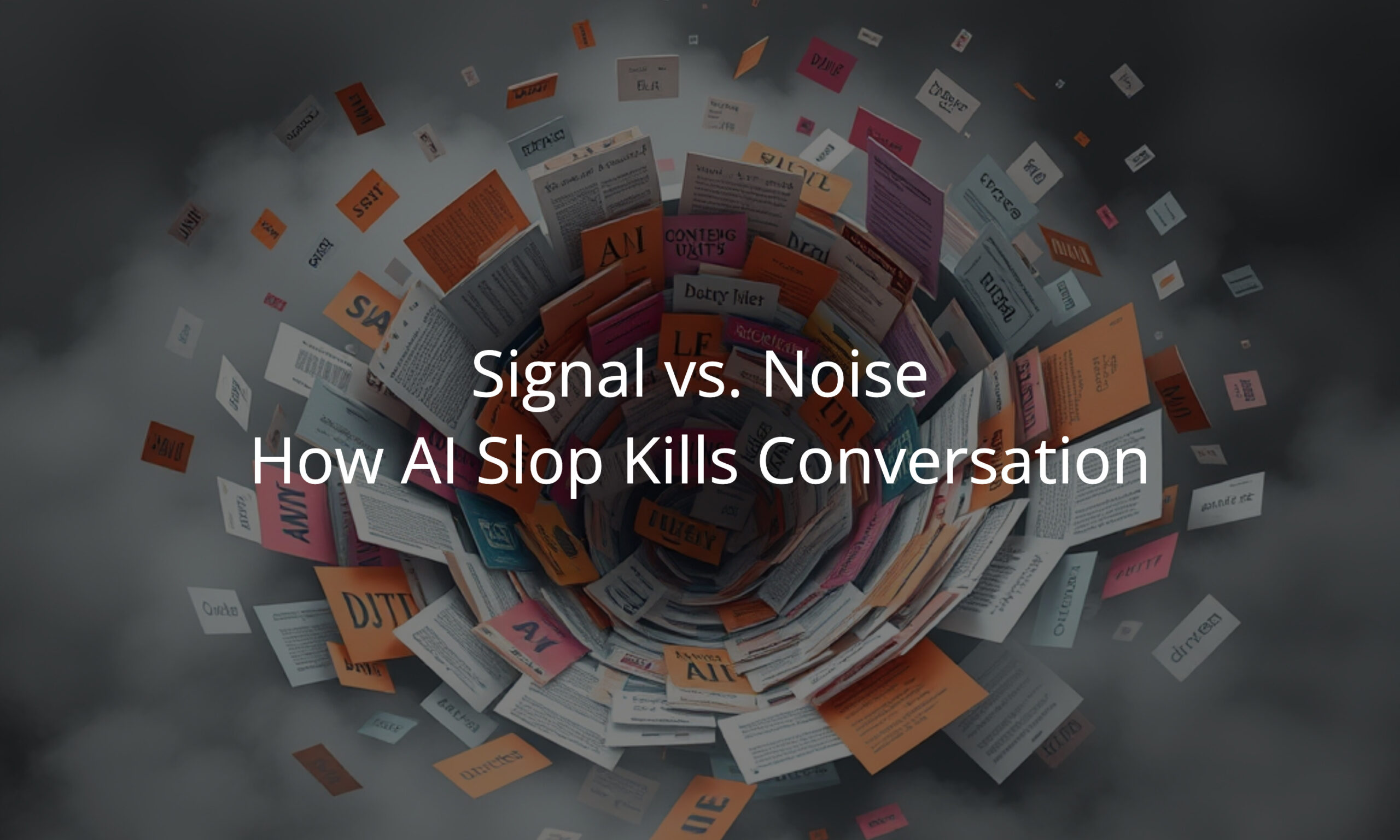Artificial intelligence is incredible.
Tools like ChatGPT, Claude, and Grok can generate blog posts, social media content, and marketing copy in seconds. For businesses struggling with content volume, this is a miracle solution.
But it’s not.
The proliferation of easy-to-use AI tools has also birthed an upwelling of AL slop – generic, template-driven content that follows predictable patterns but fails to add any substantive value. You see it on blogs, in the news, and on professional platforms like LinkedIn. The slop is legion and it’s drowning out any semblance of authenticity.
The Anatomy of AI Slop
On its own, AI-generated content tends to be well-written. It’s based on patterns gleaned from ages of human-written work so it feels natural. Until you see a lot of it, then you can’t help but identify the unmistakable fingerprints of automated generation.
Several telltale characteristics will stand out, even in an otherwise well-written piece of content.
“This isn’t about X it’s about Y.”
“I couldn’t ignore this.”
“As an expert in X with a degree from Y”
When you see these phrases once, you read right past them. When you see them all together in posts from different individuals you suddenly realize they’re all using the same toolkit. And once you see it, you can’t unsee it.
Other indicators are overly broad generalizations, usually starting with a phrase akin to “in today’s world.” Some other articles will force emoji or stylized/decorative elements into an article in a way that a human writer interacting with the tool wouldn’t naturally do.
Perhaps most telling is the emotional disconnect. AI-generated content often attempts to manufacture profound insights from mundane events, creating a tone that feels artificially elevated and disconnected from genuine human experience.
A Case Study in AI Slop
LinkedIn recently threw a post into my feed that exactly demonstrates this problem. It starts with the commong “I couldn’t ignore this” and focuses on the recent Astronomer/Coldplay affair. While the news itself is nothing like an AI hallucination, the analysis definitely seems to be.
The post features forced gravitas around a gossip-worthy incident, positioning it as a “fascinating case study in leadership accountability.” It includes an unnecessary credential drop (“As a Chartered Administrator and PhD holder in Management Sciences”) that feels awkwardly inserted rather than naturally relevant. The content follows the predictable “this isn’t about X, it’s about Y” template, and presents broad generalizations about leadership and governance that could apply to virtually any corporate scandal.
Most damning is the use of diamond bullet points to present “key reflections from a governance perspective.” This formatting choice is almost as bad as using an mdash; it just screams automated generation. The entire post reads like a ChatGPT prompt response: “Write a LinkedIn thought leadership post about CEO accountability using this news story.”
The Real Cost of AI Slop
This flood of AI-generated content creates several serious problems. First, it dramatically reduces the signal-to-noise ratio on professional platforms. Feeds filled with templated insights and manufactured profundity become unusable for finding genuine expertise and authentic perspectives.
Second, AI slop degrades trust in content overall. As readers become more aware of these patterns, they begin to question all content, including legitimately valuable human-authored pieces. This skepticism, while often justified, can lead to the dismissal of genuinely insightful work simply because it might appear AI-generated.
Third, the proliferation of AI slop creates a race to the bottom in content quality. Many algorithms focus on volume because they’re incapable of rating value. Pairing that with AI tools that render producing vast amounts of sloppy content trivial and the incentive to invest in thoughtful, well-researched pieces is gone.
The Right Way to Use AI
This current reality of AI tools is frustrating, but there’s a silver lining. After all, a computer can only do what we tell it to do – so it’s our instructions that are problematic rather than the AI tools themselves.
We just need a better way to deploy that functionality.
Where AI excels is as a collaborative partner. Not as a replacement for human creativity and expertise.
Effective AI use involves leveraging these tools for ideation, research assistance, and draft refinement rather than wholesale content generation. A human expert might use AI to brainstorm angles for a piece, research supporting data, or polish their prose. The core insights, structure, and voice remain authentically human.
The key distinction is agency.
When humans use AI to enhance their own expertise and perspective, the result maintains authenticity and value. When AI is used to manufacture content from scratch, mimicking expertise the user doesn’t possess, the result is slop.
Moving Forward
As AI tools become more sophisticated, the challenge is cultural. We need to develop better norms around AI use in professional communication. This means being transparent about AI assistance when appropriate, prioritizing authentic expertise over volume.
It also means training ourselves to recognize and value genuine human insight.
For content creators, the solution is easy: use AI as a writing assistant, not a writing replacement. Let these tools help you research, organize, and refine your genuine expertise. Don’t use them as substitutes for your unique perspective and hard-earned knowledge.
For content consumers, learn to detect AI slop. This skill is becoming as fundamentally important as media literacy. Learn to recognize the patterns, trust your instincts when something feels artificially generated, and actively seek out creators who demonstrate genuine expertise and authentic voice.
We don’t need to aim to eliminate AI from the creation of content. It’s a matter of assuring that, when and where AI is involved, it’s being used to amplify human intelligence rather than replace it.



